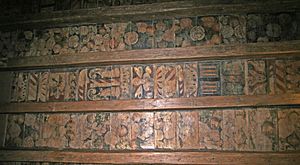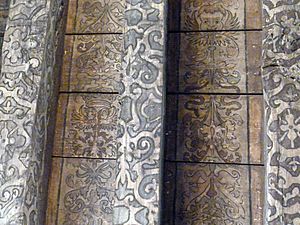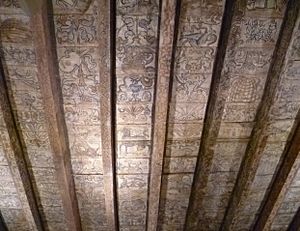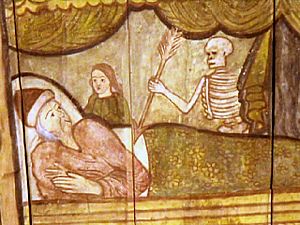Scottish Renaissance painted ceilings facts for kids
Scottish renaissance painted ceilings are special decorated ceilings found in Scottish homes and castles built between 1540 and 1640. This was a unique style for Scotland, but it shared some ideas with similar artwork in countries like France, Spain, and Scandinavia. More than 100 of these painted ceilings have been recorded, but only a few still exist today in their original places. Some painted wooden pieces are kept safe by Historic Environment Scotland. The paintings at Crathes Castle, made in 1597 and 1602, are probably the most famous examples.
Contents
What Were These Ceilings Made Of?

Most of these amazing ceilings were painted directly onto the wooden boards and beams that formed the floor of the room above. Sometimes, rooms or long hallways in attics were completely covered with thin pine wood panels, which were then painted. The wood, often oak and pine, was brought in from places like Denmark, Norway, and Sweden. This imported wood was known as "Eastland" timber.
Over time, this style of painted ceiling became less popular. People started to prefer decorative plasterwork instead. Sadly, many painted ceilings were even taken apart to create a base for the new plaster. For example, in Edinburgh, a large hall in Sir Thomas Hope of Craighall's house had a painted ceiling hidden above a newer plaster ceiling. You could only see it by lifting the floorboards in the room above! The painted ceiling at Huntingtower Castle was also hidden this way until it was discovered.
Who Painted These Ceilings?

The artists used paint made from a special glue, often from old leather, mixed with chalk and colors. They used natural colors like ochre (yellow-brown), vermilion (bright red), and orpiment (yellow), often mixed with indigo (blue) to make bright greens. Some painters added a shiny varnish made from pine resin and walnut oil to certain parts of their designs.
Most designs seem to have been painted by hand. However, some patterns on the ceiling boards at Riddle's Court might have been traced using a method called "pouncing," where a pattern is pricked with holes and then dusted with charcoal to transfer it.
We know the names of many painters from old records, but it's hard to say which painter created which specific surviving ceiling. We do know that in 1554, painters in Edinburgh, led by Walter Binning, even attacked another painter, David Warkman, for painting a ceiling! Walter Binning himself painted a new gallery at Holyrood Palace in 1577. It seems that only very rich merchants and nobles could afford this kind of decoration.
The walls of these rooms were also often painted, but this wall art usually hasn't survived. At a merchant's house in Kirkcaldy, a ship painted above a fireplace might show the Angel of Kirkcaldy, a ship that brought Anne of Denmark and James VI and I home in 1590.
What Kinds of Pictures Were Painted?
Many ceilings feature patterns of fruits and flowers, sometimes looking like fancy tapestry borders. These often included religious symbols. Some ceilings in long galleries at the top of buildings had small pictures or "vignettes" showing scenes from the Bible or symbolic images. Others used Renaissance-style decorations, including strange or fantastical creatures and symbols.
One gallery in a building on Edinburgh's Castlehill (which is now gone) had scenes from the Apocalypse (the end of the world) and Christ asleep in a storm. These scenes were even set in the Firth of Forth, with Edinburgh's skyline in the background! Pieces of this ceiling are now kept at the National Museums of Scotland.
Some ceilings were painted with rows of family crests or shields, like those at Earlshall Castle and Collairnie Castle. Some ceilings from the 1600s even included the signs of the zodiac.
You can see several surviving painted ceilings in Edinburgh at places like John Knox's House, Gladstone's Land, and the Canongate Tolbooth museum. The birthroom at Edinburgh Castle was painted to celebrate James VI's 50th birthday. Gladstone's Land, built in 1619, also has well-preserved paintings on its plaster walls, matching the ceiling.
More wall paintings from the 1550s can be seen at Kinneil House, made for Regent Arran. Aberdour Castle has one of the latest ceilings (around 1633), while Huntingtower Castle has one of the earliest (around 1540). The ceilings at Crathes Castle are decorated with the Nine Worthies (famous heroes) and the Muses (goddesses of arts and sciences). Like Crathes, beams at Traquair House and Sailor's Walk in Kirkcaldy have wise sayings and Bible verses written in Middle Scots.
A gallery at Provost Skene's House in Aberdeen looks similar to the Castlehill painting. Two examples in churches, St. Mary's, Grandtully and the Skelmorlie Aisle at Largs, are painted on the thin wooden panels of curved ceilings. Culross Palace, built by George Bruce of Carnock, has many painted rooms with symbols, geometric patterns, and Bible scenes.

Other painted ceilings are still in private homes. Many were carefully removed and saved by Historic Scotland, including two from Dysart, Fife. The National Museum of Scotland displays a ceiling from Rossend Castle. The Stirling Smith Museum and Art Gallery has a ceiling from Robert Drummond of Carnock's house. A room from Alexander Seton, 1st Earl of Dunfermline's Pinkie House is shown at the Museum of Edinburgh.
Painted ceilings hidden by later plasterwork are still being found today! Parts of a ceiling made for George Keith, 5th Earl Marischal survive at Keith Marischal. A very high-quality ceiling with strange creatures and swirling patterns was found at Moubray House on Edinburgh's Royal Mile in 1999. Another ceiling on the Royal Mile was discovered in 2010 in Clement Cor's house.
Where Did the Designs Come From?

Many of the ceilings feature pictures or symbols taken from European printed books. These books were very popular among the wealthy and educated people in Scotland. For example, in 1584, the poet William Fowler told a German traveler that he was teaching James VI and I about the "art of memory," and the king taught him about poetry and "emblems" (symbolic pictures with meanings).
The ceiling at Prestongrange, painted for Mark Kerr and Helen Leslie in 1581, has funny figures from a French book called Les songes drolatiques de Pantagruel (1565). Nicolas Elphinstone gave James VI a copy of this book. Other decorations came from engravings by Hans Vredeman de Vries and Gerard de Jode.
At Rossend Castle, the ceiling (now in the National Museum of Scotland) used symbols from books by Claude Paradin, Gabriele Simeoni, and Alciato. It also included decorative details from Vredeman de Vries's Grottesco, showing symbols of European princes. A ceiling at Riddle's Court in Edinburgh has the eagle of the Holy Roman Empire combined with a thistle. This might have been to celebrate the visit of the Duke of Holstein in 1598.
Inscriptions on wooden beams from Carnock House, dated to 1589, include wise advice in Scots from ancient philosophers and Bible sayings. Symbols at Culross Palace were taken from a book called A Choice of Emblems by Geffrey Whitney (1586). Tiny engravings by the French goldsmith Etienne Delaune provided the decorations at the Skelmorlie Aisle. These examples show how Scottish painters and their wealthy customers used popular Renaissance pattern books.
Saving These Old Paintings

For a long time, people didn't talk much about these painted ceilings. In the 1680s, a lawyer named John Lauder, Lord Fountainhall saw the painted symbols at Pinkie and thought they were a bit too academic. In 1746, a soldier named James Ray saw the ruins of Huntly Castle and mentioned that its ceilings were still decorated with "history-painting."
Most of these ceilings were hidden behind newer decorations or simply forgotten in buildings that became less important. In the early 1800s, people started to get interested in them again when buildings were being torn down in Edinburgh and Dundee. Experts like Charles Kirkpatrick Sharpe and Rev. Sime saved parts of the Apocalypse painting from Edinburgh's Castlehill and made colored drawings of it.
Modern efforts to save painted ceilings in Scotland began at Huntingtower in 1912. Experts used special solutions to fix the paint that was flaking off. In the mid-1900s, the National Trust for Scotland and the Ministry of Works even set up a special center in Edinburgh to focus on saving these paintings. Many conservators (people who preserve old art) worked hard to rescue and save a number of painted ceilings.
More recently, experts like Michael Bath have studied the symbols and their meanings in these ceilings. Other researchers have explored different ways to preserve them and have used scientific methods to date the wood used in the ceilings. This ongoing work helps us understand and protect these beautiful historical artworks for future generations.
|



